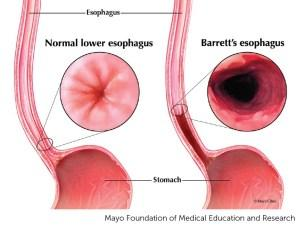Blog
Barrett's Esophagus
OVERVIEW: WHAT IS BARETT’S ESOPHAGUS?
Barrett’s esophagus is thought to develop primarily from chronic regurgitation of acid as a result of a longstanding condition of gastroesophageal reflux disease (GERD) though the exact cause is not known. Barrett’s Esophagus occurs when the normal cells that line the lower part of the esophagus (called squamous cells) are replaced by intestinal cells.
This type of change is commonly noted following repetitive damage to the inside of the esophagus caused by longstanding gastroesophageal reflux disease (GERD). In people with GERD, the esophagus is repeatedly exposed to excessive amounts of stomach acid and bile. This takes place in the area where the esophagus is joined to the stomach.

COMMON SYMPTOMS OF BARRETT’S ESOPHAGUS
Barrett’s esophagus doesn’t have any specific symptoms associated with it that medical experts are aware of. There are companion symptoms that are common to having GERD which seem to directly correspond with that of Barrett’s Esophagus diagnosis. Those symptoms include:
- Heartburn
- Indigestion
- Regurgitation
CAN BARRETT’S ESOPHAGUS BE HEALED OR REVERSED?
There isn’t a cure for Barrett’s Esophagus. The medical approach to Barrett’s Esophagus includes incorporating some treatment methods to help avoid further damage to the esophagus. There are some schools of thought that the condition can “go away” on its own, but much is dependent upon severity at the time of diagnosis.
Some of the common treatments include trying to destroy damaged tissue with some specific methodologies that may include: heat (radiofrequency ablation, thermal ablation with argon plasma coagulation and multipolar coagulation), cold energy (cryotherapy) or the use of light and special chemicals (photodynamic therapy).
Your gastroenterologist can better advise on a personal treatment plan if you or someone you know has Barrett’s Esophagus. As specialists in the field, what we know is that consistent monitoring plays a crucial role as does finding ways to reduce the symptoms associated with the condition.
LIVING WITH BARRETT’S ESOPHAGUS – WHAT TO EXPECT
Those who are diagnosed with Barrett’s Esophagus can expect to live a normal life. This condition is treatable and doesn’t hold any risk of premature death. However, Barrett’s Esophagus is a serious condition and should be under the treatment guidelines recommended to you by a gastroenterologist.
Researchers advise staying under the constant care of your treating Gastroenterologists and following these best practices:
- Abstaining from smoking and/or second-hand smoke
- Staying at an ideal weight and BMI
- Staying active and getting enough exercise
- Eat a diet rich in fruits and vegetables.
- Avoid eating close to the time you go to bed.
- Avoid foods and beverages that promote heartburn, including alcohol, caffeine, chocolate, peppermint, onions, green peppers and foods that are high in fat, all of which can relax the muscle that prevents stomach acid from washing up into the esophagus.
- Take antacids as needed for occasional heartburn. Talk to your doctor about personal recommendations.
HOW OFTEN DOES BARRETT’S ESOPHAGUS TURN INTO CANCER?
There is concern that Barrett’s Esophagus has the potential to develop into esophageal adenocarcinoma. Patients with Barrett’s esophagus should be enrolled in a surveillance program to look for signs of abnormal tissue (dysplasia) or cancer. This is described as a notable precancerous change that is one of the leading catalysts to the development of cancer.
It is important to note that the risk of developing esophageal cancer from an existing condition of Barrett’s Esophagus is still relatively low. Statistics reveal about 1 per 300 patients with Barrett’s Esophagus are diagnosed with cancer.
A study found that out of every year, 0.12 percent of patients — or about one in 860 people — go on to develop cancer of esophageal cancer.
INTERESTING FACTS ABOUT GERD AND BARRETT’S ESOPHAGUS
- GERD affects an estimated 25%-35% of the US population (7%-10% with daily symptoms).
- 10%-20% of patients with chronic GERD symptoms have Barrett’s Esophagus.
- 44% of Barrett’s patients lack consistent severe GERD symptoms.
- Barrett’s Esophagus patients have 30-125 times greater risk of developing esophageal cancer.
- The incidence of esophageal adenocarcinoma is rising more rapidly than any other cancer, a six-fold increase from 1975 to 2001.
- The prevalence of Barrett’s Esophagus in the general population is 1.6%, approximately 3.3 million in the United States.
- In an endoscopic series of patients, 0.9%-4.5% had Barrett’s Esophagus. The prevalence of cancer, high-grade dysplasia, and low-grade dysplasia in Barrett’s Esophagus are 6.7%, 3.0%, and 7.3%, respectively.
- The incidence rate of cancer, high-grade dysplasia, and low-grade dysplasia in Barrett’s Esophagus are 0.5%, 0.9% and 4.3% per year, respectively.
- 5% of patients with Barrett’s Esophagus develop esophageal cancer within 5-8 years of diagnosis.
- The incidence of high-grade dysplasia progressing to cancer is 10% (range 6%-19%) per year.
- The incidence of low-grade dysplasia progressing to cancer is 0.6% per year.
- 53% of patients with cancer/high-grade dysplasia have no dysplasia at their first two scopes.
- Genetic variation in two chromosomes has been linked to the development of Barrett’s Esophagus.
DIAGNOSING BARRETT’S ESOPHAGUS
Barrett’s esophagus is diagnosed by the results following an endoscopy. By performing an endoscopy, there is an opportunity to notice or observe any relative changes in the lining of the esophagus. A biopsy of the tissue taken at the time of surgery will be used as a confirmation of any diagnosis being made.
SHOULD YOU TALK ABOUT BARRETT’S ESOPHAGUS WITH YOUR GASTROENTEROLOGIST?
Having concerns about your health is normal and we encourage honest conversations with your physicians –especially if you are experiencing symptoms from possible GERD or Barrett’s Esophagus. In our practice, we have helped many understand their conditions better. Contact us with any questions or for a consultation, we have flexible scheduling and we have a caring team in place dedicated to our patients and community.